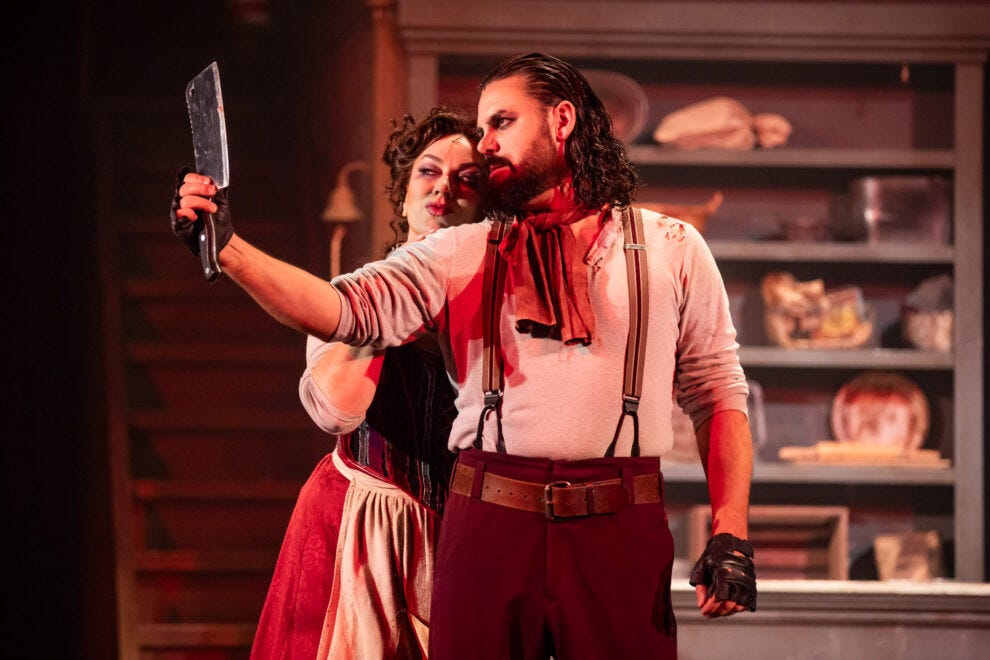Gore and Grandeur: Sweeney Todd (Victorian Opera) Review
Are you still afraid of the demon barber of Fleet Street?
Victorian Opera’s new production of Sweeney Todd, which opened last night at Arts Centre Melbourne's Playhouse, was nothing short of sensational. Directed with boldness and flair, this production of Stephen Sondheim’s iconic musical brings the full force of the tale’s macabre humour and grisly undertones to the stage.
Set in the more intimate confines of the Playhouse, the production capitalised on the venue's proximity to the audience. The smaller space amplified the claustrophobic atmosphere of Fleet Street, making every razor slash, bloody scream and orchestral shriek all the more visceral. This closeness also gave the audience a chance to revel in the finely tuned performances of the cast, each member bringing their own distinct energy to the famously dark characters.
Ben Mingay’s portrayal of the eponymous demon barber, Sweeney Todd, was commanding, his powerful baritone cutting through the dark score with ease. Mingay’s brooding, tortured performance captured both Todd’s desire for revenge and the overwhelming grief that drives him. Yet it was Adrian Tamburini’s Judge Turpin who left the most indelible mark on the audience. Tamburini’s chilling depiction of the lustful, corrupt judge was harrowing, particularly in his sexual and grotesque rendition of "Mea Culpa," where his character’s shameful desires were laid bare.
Antoinette Halloran shone as Mrs. Lovett, perfectly balancing the character’s dark humour with her own brand of chaotic charm. Her chemistry with Mingay was electric, especially during "A Little Priest," where their playful plotting of human-filled pies had the audience simultaneously laughing and squirming. Halloran’s voice was as sharp as her character’s wit, making her portrayal of the opportunistic baker one of the highlights of the night.
The rest of the cast delivered equally powerful performances. Mat Verevis as Tobias Ragg provided an emotional anchor, particularly in his tender rendition of "Not While I'm Around," while Alessia Pintabona’s Johanna offered a beautifully tragic counterpoint to the darker aspects of the story. Kanen Breen’s flamboyant Beadle and Euan Fistrovic Doidge’s exaggerated and well-dressed take on Adolfo Pirelli added moments of absurdity to this otherwise grim tale.
Director Stuart Maunder embraced the full potential of Sweeney Todd’s more shocking elements. The production’s unflinching depiction of blood, lust, and vengeance was refreshingly unrestrained, with Maunder taking the gore to its theatrical limit without tipping into the gratuitous. The intimacy of the Playhouse only heightened these moments, drawing the audience into the visceral horror of Todd’s ejecting barber chair and Mrs. Lovett’s grisly kitchen and bakehouse.
What made this production so successful was its willingness to lean into the sexual and violent aspects of the narrative. Judge Turpin’s disturbing obsession with Johanna was portrayed with chilling clarity, and Todd’s descent into madness was carefully built, with each act of violence pushing him further into moral oblivion. These darker elements were handled with care, ensuring the production remained tense, gripping, and, at times, unsettling.
Roger Kirk’s set and costume design perfectly captured the grimy, industrial atmosphere of Victorian London. The set, with its crumbling street and foreboding woodwork, evoked the decaying world of Fleet Street. The costumes were equally detailed, with Mrs. Lovett’s rags and riches dresses and Todd’s returned convict attire contrasting starkly with the regal garments of Judge Turpin. The set changes were smooth, transitioning effortlessly from the seedy streets to Todd’s horrific barbershop.
Under the baton of Phoebe Briggs, the Victorian Opera Chamber Orchestra delivered an extraordinary performance, breathing life into Sondheim’s complex score. The richness of the music filled the intimate space of the Playhouse, with the orchestra moving seamlessly between the sweeping melodies of *"Johanna"* and the discordant, jagged rhythms of *"Epiphany."* The balance between the singers and the orchestra was impeccable, allowing every lyric and musical flourish to be heard clearly, while heightening the drama and tension of the production.
For those who want their musical theatre dark, daring, and deliciously macabre, this is a must-see. As the Demon Barber himself might say, “Attend the tale.” You won’t regret it.




